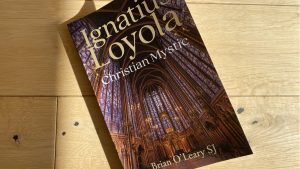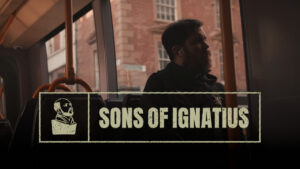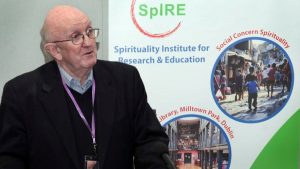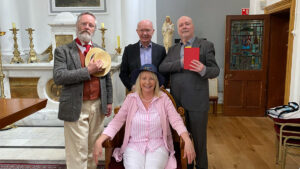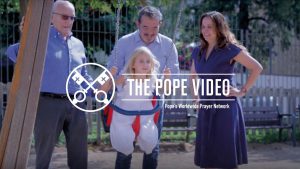‘Catholic Church needs National Assembly’

“The Irish Catholic Church urgently needs a National Assembly in order to address the deep crisis in which it is embroiled. And since the crisis has implications for the Church world-wide, there will also be the need for a Third Vatican Council”. So argues Jesuit theologian Gerry O’Hanlon in his latest book, A New Vision for the Catholic Church: A View from Ireland (Columba Press), launched by Pat Coyle, Manager of the Jesuit Communication Centre (read her address below) on Monday 16 May, 2011, in Gardiner St Church, 5.00pm. John Guiney SJ, Director of the Jesuit Centre for Faith and Justice, chaired the event. Gerry O’Hanlon told those gathered that the Church needs to return to the vision of Vatican II, and foster an inclusive culture of conversation and dialogue.
Launch of A New Vision for the Catholic Church: A View from Ireland by Gerry O’Hanlon
Pat Coyle
“The fall out from the clerical child sexual abuse scandal has shown us that our current model of Church is ‘nonsense’ – and we have an important and urgent responsibility to address this issue.”
The words of Gerry O’Hanlon in the book I am privileged to be launching this evening. Strong and straight talking – characteristic of the book.
This is not a book which allows the reader to confirm their prejudices about what they always knew was wrong with the Church, (or even about the Jesuits who write about it). It is a book which calls on those who even half-care about the Church’s future and their role in it, to imagine that they can be part of the struggle for change.
If this is challenging, then comforting is the work that the author has done to help develop a strategy for the struggle. And to find the support of unlikely companions along the way.
The nonsense Gerry O’Hanlon refers to in describing our current model of church is, he tells us, “the nonsense referred to by Pius XI in 1939 when addressing a group of Canadian seminarians in Rome, shortly before his death”. He quotes the Pope who said:
I want you to take this message away with you. The Church, the mystical body of Christ, has become a monstrosity. The head is very large but the body is shrunken. You, the priests, must rebuild that body of the Church, and the only way that you can rebuild it is to mobilise the lay people.
This book is an important contribution to that mobilisation. It grew out of a dialogue with mostly lay people who came last winter to the Jesuit Centre for Spiritality in Manresa, to discuss with the author and each other their reflections, disillusionment, grief, anger and concern for the Church they were part of but often felt alienated from. It was reminiscent of the Emmaus gospel story of last Sunday week. Fairly disheartened, they met someone who went back to the foundations of scripture with them, and shone a light not so much on the content of faith but rather on the dynamic process of self-understanding that has been the history of the Church – always partial, always imperfect.
This book came out the author’s talks and the follow-up debate on those November nights. And we learn from it that tradition is important but should never become tyranny. People of the Church are beings in time, challenged by a crucified and risen Lord to appropiate what he means for their times.
The clear, focussed and condensed narrative covers the early days of the Chruch as small Christian communities on to its formal recognition by Constantine in Rome. It moves through heresies and holy wars to Vatican I and the ever solidfying primacy of the papacy which gives rise to a clericalist papist culture that the author characterises as ‘dysfunctional’
In this way he illuminates the context in which Vatican II emerged. He sifts out the key elements that could inform our conversation and spark the imaginations of those who wish to construct a new Church in the spirit of Vatican II.
Drawing on Canon Lawyer Orsy and the Jesuit historian O’Malley, he takes us back to the early days of the Second Vatican Council – days of hope, angst and, yes, even humour! One story recounted concerns the beginning of the Council, when many were surprised to find that a goodly number of bishops were in favour of change on many fronts, liturgical , theological, ecclesiological and so on… The author continues:
But there was also a very able minority with strong roots in the Curia, headed by the likes of Cardinal Ottaviani, Ruffini, and the Irishman Cardinal Michael Browne – all much opposed to change of any kind . Ottaviani in particular came to embody everything that people disliked about the Holy Office (predecessor of the Congregation for the Doctrine and Faith), and jokes about him circulated widely and appeared in newspapers and journals. One morning – supposedly – he called a taxi and directed the driver to take him to the Council. The driver hit the road for Trent.
Humour is really imortant for anyone intent on living even a half-human life, but the most important factor regarding this book is that by locating the conversation he believes must take place, in a historical context, Gerry O’Hanlon creates the possibility of a much needed debate on the nature and future of the Catholic Church which does not allow one side or the other to claim possession of ‘the truth’.
Rather, the hope is that by, struggling in as open ,honest and well informed way as possible-the truth may posses those who seek. Quoting O’Malley the author succinctly puts it: “If it was not always thus, it need not always be thus”.
It is clear therefore that this book is of value not just to Catholics in Ireland but to Catholics around the world, those trying to remain within the Church structure, those floating round the fringes and those, Christian and non-Christian, who are interested in a detached but enquiring way.
But it is more than an accessible, academic work. It is a call to action. The author is aware that strong words about involvement of the laity, empowering women in the Church, changing structures, working in a collaborative as opposed to topdown manner, are just that – strong words. There have been many such words for many many years. The conversation concerning the way our Catholic institution treats women is not new. The only new contribution in years was the banning of it (in regard to women priests) by John Paul II.
As a theologian who has often spoken out on these issues Gerry O’Hanlon believes that what we must have now is action. And in this book he calls for a National Assembly of the Irish Catholic Church. In the final pages he even outlines proposals as to how this All-Ireland body might be constituted.
People on the move in time of crisis and urgency cannot afford to carry extra baggage. He tells us that there have been many nice people with good hearts who have been part of the institutional church but warns us that what we must be engaged in, in such a synod, is a critque of structure not a criticism of persons.
‘We need to go beyond the notion that just because individual priests, popes or bishops are nice or fine people that therefore we can leave things as they are…. We have been alerted to deep cultural, structural flaws in our Church and we need to tackle them with or in opposition to the good people who are in positions of authority.
This is an important call which deserves attention and support. But it is not going to be easy as any such forum would of its essence need to challenge and embody in its being values that are completely counter cultural to those of our institutional Church.
Listening with humility not defensivesness to those who have been abused , truly hearing the voices of those treated unjustly, allowing for the voice of the ’other’, whomever that ‘other might be’: experiencing powerlessness and doubt when power and truth are your unquestioning perogative – is truly challenging for everyone involved. For many it is also frightening and understandably so: meaningful change will exact a price.
Vatican II saw the church wake up to the world in which it lived, and try to make itself relevant through engagement with that world, for its relevance was at stake.
Today it is not its relevancy that is in peril- it is its very credibility. Can the Church, faithful, dissenters, religious, lay, change enough so that our Chuch, institution included, becomes a credible force for good, embodying the love and vision of Christ, in the world? This book of Gerry O’Hanlon’s which we launch tonight answers yes and shows us a way to begin.
But its a way that calls for people of real courage and integrity and so on a personal note I want to finish by paying tribute to Gerry O’Hanlon who is for me such a person.
Thirty years ago he preached a sermon on Trinity Sunday and asked -What difference does it make to you that God is there? 30 years later I still find myself pondering that question. And he has posed many such provocative questions down the years in that calm, deliberative, unflappable manner that can at first inure you to the really controversial nature of his enquiry.
Meeting him and working with him in these recent years I have been touched by his ongoing concern for the poor and for those wounded or treated unjustly by the ‘official’ Church – women, the gay community and, more recently, survivors of abuse.
I have been reassured by the theological acumen and genuine personal commitment that he brings to their case. This latest book is testament to that. It may also be his biggest challenge.




